
Access Guide
Each/Other Access Guide
“You are now an accomplice.
You are now a collaborator.
You are now invested.”
—Marie Watt and Cannupa Hanska Luger
Introduction
Each/Other: Marie Watt and Cannupa Hanska Luger
Today, we place value on the noun, “art,” and not the verb, “to create.” Yet for much of history, art was an act of shared creation. For Marie Watt and Cannupa Hanska Luger, art is a social project where participants become invested and forge relationships. This experience facilitates learning, supports mental health, and develops new skills and ways of seeing. Their art comes from—and aims to produce—activism and social engagement.
As you walk through the exhibition, look beyond the idea of art as a noun. Search for signs of different hands that created the artworks. Think about the people who sewed or formed beads or shared stories. Think about how animals or the land collaborated to form materials. Ask yourself, when encountering each piece, “How am I part of this story?” The works are tangible, but more importantly, they are memories of collaborations that show us how to come together and take part in something greater than ourselves.
Artists:
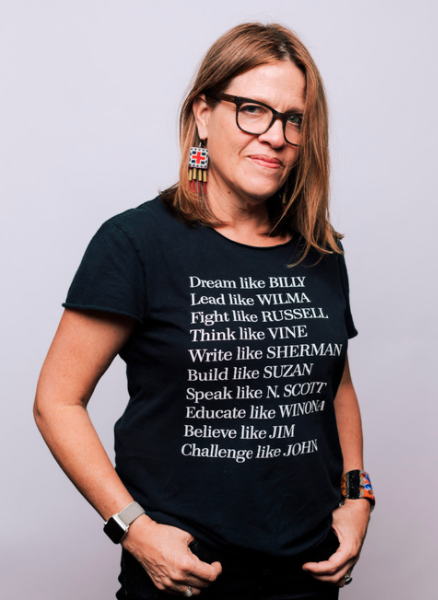
2020, taken by Sam Gehrke.
Marie Watt
Based in Portland, Oregon, Marie Watt (b. 1967) is a citizen of the Seneca Nation whose practice explores multiple materials and the collaborative act of artmaking. Her artworks are held in collections across the United States and Canada, including the Denver Art Museum, the Portland Art Museum, the Whitney Museum of American Art, Crystal Bridges Museum of American Art, and the National Gallery of Canada.
Watt has received public art commissions from the Tacoma Art Museum, the Bill and Melinda Gates Foundation, the Denver Art Museum, and the United States Embassy in Islamabad, Pakistan, through the U.S. State Department’s Art in Embassies program.
Watt exhibits internationally and is represented in Portland by PDX Contemporary Art, in Seattle by Greg Kucera Gallery, and in New York by Marc Straus Gallery.

2019. Photo by Brendan George Ko.
Cannupa Hanska Luger
Born on the Standing Rock reservation in North Dakota, Cannupa Hanska Luger (b. 1979), a New Mexico-based interdisciplinary artist, is a citizen of the Three Affiliated Tribes (Mandan, Hidatsa, and Arikara), of the Fort Berthold Reservation. His artworks address environmental justice and gender violence. From 2018 to 2020, Luger received fellowships and awards from such organizations as the Smithsonian Institution, the Center for Crafts, the Joan Mitchell Foundation, and the Museum of Arts and Design.
Luger has exhibited at Princeton University Art Museum, Art Mûr, Crystal Bridges Museum of American Art, Orenda Gallery, and the National Center for Civil and Human Rights, among others. Luger holds a BFA in studio arts from the Institute of American Indian Arts and is represented by Garth Greenan Gallery in New York.
Credit
Each/Other: Marie Watt and Cannupa Hanska Luger is organized by the Denver Art Museum and presented with the generous support of the National Endowment for the Arts, The Robert Lehman Foundation, Stelo, and Native Arts and Culture Foundation.
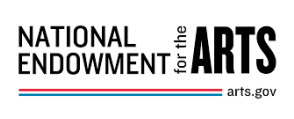
In Atlanta, this exhibition has been made possible with generous support from the Charles S. Ackerman Fund, the Carlos Museum’s National Leadership Board, Lauren Giles, Gail and Clark Goodwin, the Grace W. Blanton Lecture Fund, the LUBO Fund, and Sarah Hill.
MARIE WATT
About her work:
Marie Watt models her approach to artmaking on Indigenous ways of sharing knowledge and learning. By organizing sewing circles, she creates space for face-to-face, multigenerational gatherings of people from different backgrounds and life experiences who share stories—sometimes unscripted and at other times following a thematic prompt. She sees her role in the process as “setting the table” but allows for each person to engage at any level they wish. Each person’s stitch is unique but comes together with those of others to create something larger than themselves. Canine forms and references found in her work highlight this “pack” experience. Taking part in one of her sewing circles can be powerful. Connections form among those who contribute to a project. For participants, it is the time spent together creating that makes the process memorable.

Trek (Pleiades), 2014
Reclaimed wool blankets, satin binding, embroidery floss, and thread
Tia Collection, Santa Fe, NM
Inspiration can come from near and far—from family mementos to the outer reaches of space. Watt’s acknowledgment of her sources of inspiration, such as Star Trek, adds nuance to our understanding of collaboration. We are all connected through those who came before us, the stories passed down through generations, and those whom we come to know. When these connections manifest themselves in an artwork, the artist engages in a form of collaboration.
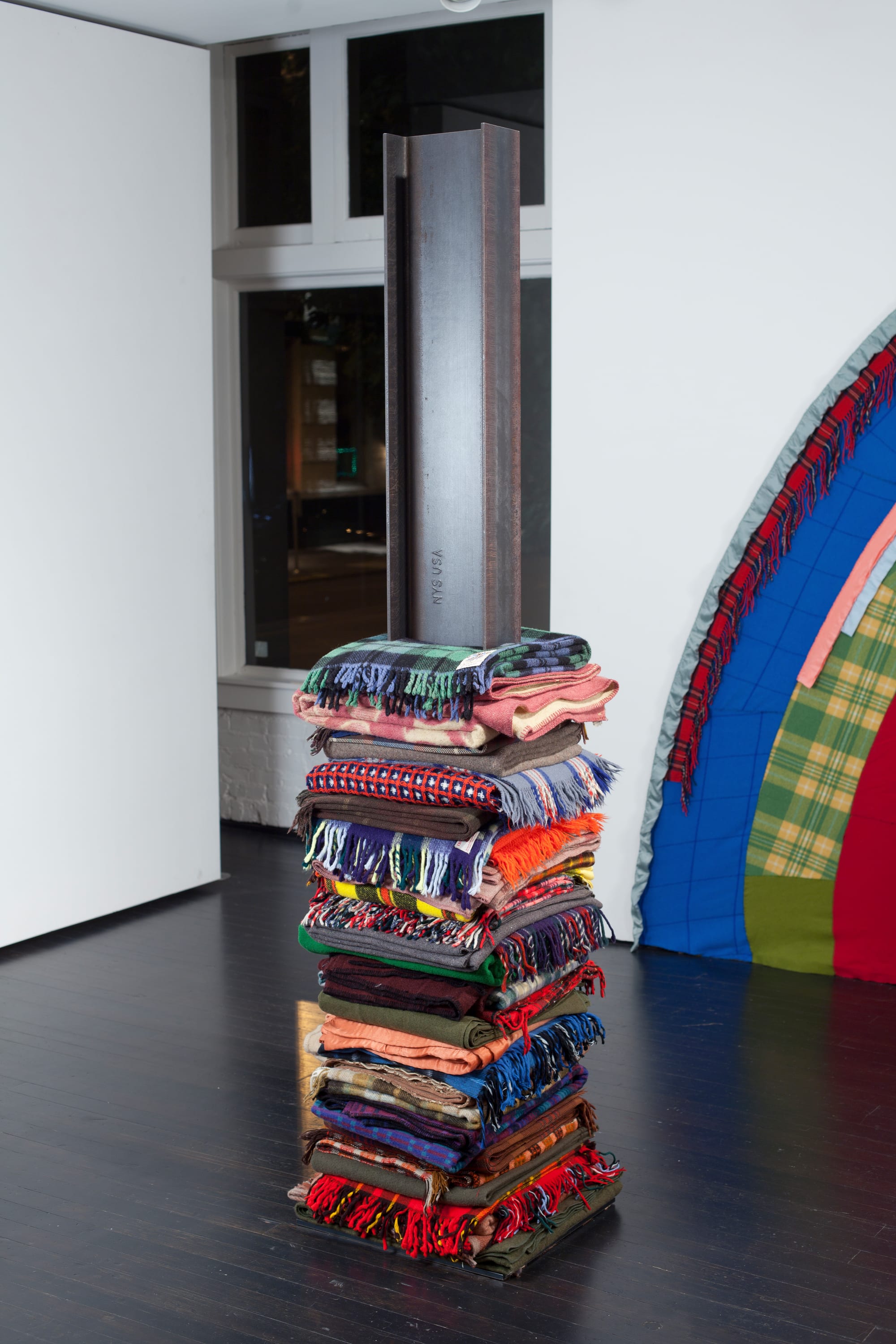
Skywalker/ Skyscraper (Babel), 2012
Reclaimed wool blankets and steel I-beam
Lent by Brian A Tschumper
Courtesy and © of the artist and PDX Contemporary Art.
Skywalker/ Skyscraper (Babel)
Tall buildings occupy the sky but remain rooted to the ground—and take a collaborative effort to build. Since 1916, Haudenosaunee (Iroquois) ironworkers, known as “skywalkers” for their skill and bravery in working on high steel beams without safety harnesses, helped build Manhattan’s skyscrapers. Juxtaposing hard steel with soft blankets, Watt asks us to think about how we seek to reach the sky and the collective actions we take to achieve this dream.
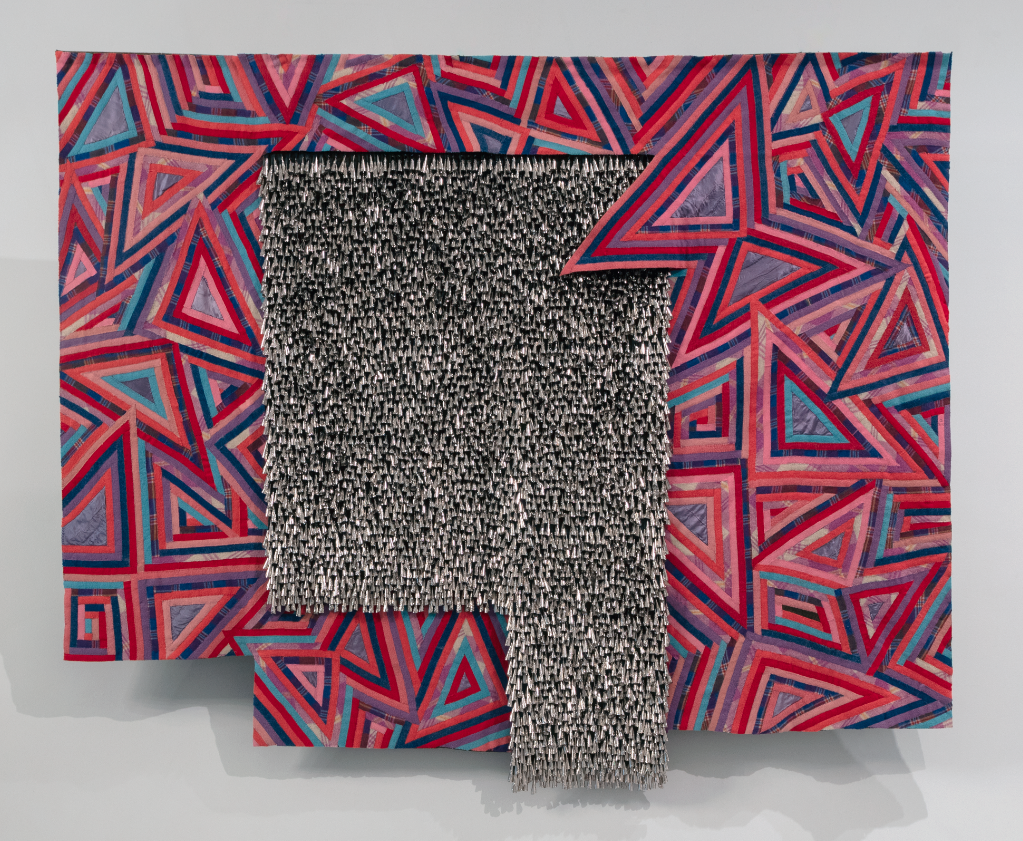
Butterfly, 2015
Reclaimed wool blankets, satin binding, thread, cotton twill tape, and tin jingles
Denver Art Museum: Funds from Loren G. Lipson, M.D., Vicki & Kent Logan, with additional funds from Brian A Tschumper, Nancy Benson, Jan & Mike Tansey, and JoAnn & Bob Balzer, 2016.1A-B. © Marie Watt
In the summer of 2013, Watt was an artist in residence at the Denver Art Museum, where she organized sewing circles with the community to create monumental textiles. This work was inspired by two young Indigenous girls who told her about their experiences as powwow dancers: one who shared that she feels like a floating butterfly while dancing and another who told the origin story of her jingle dress and its ties to healing.
Marie Watt (Seneca and German-Scots)
Blanket Stories: Great-Grandmother, Pandemic, Daybreak, 2021
Blankets, manilla tags, and cedar base
Collection of the Jordan Schnitzer Family Foundation
Marie Watt invites viewers to participate in her artmaking practice and infuse the works with individual and collective meaning. People in Georgia and twenty other U.S. states donated the blankets in this sculpture. Each tag contains a story that shares the blanket’s significance. These stories, one of which recalls a great-grandmother, collectively embody “family memory,” evoking the comfort provided by family, community, and memory during the COVID-19 pandemic.
In the title, Watt invokes the hope of sunrise and the poem “Singing Everything” by U.S. Poet Laureate Joy Harjo, a citizen of the Muscogee Nation:
“Once there were songs for everything,
Songs for planting, for growing, for harvesting,
For eating, getting drunk, falling asleep,
For sunrise, birth, mind-break, and war…”
Marie Watt (Seneca and German-Scots)
Antipodes, 2020
Vintage Venetian glass beads, thread, cotton twill tape, industrial felt, and steel
Courtesy of the artist, Marc Straus Gallery, PDX Contemporary Art, and Greg Kucera Gallery
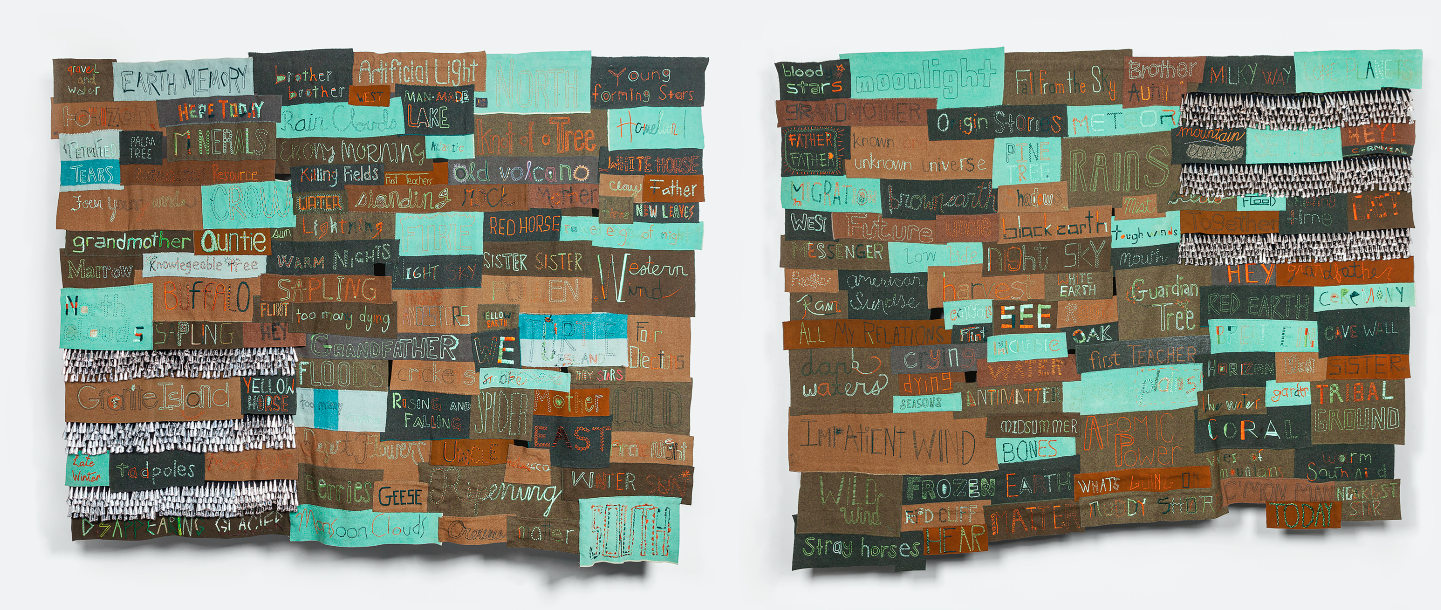
Companion Species: Assembly (Auntie) and Companion Species: Assembly (Guardian Tree), 2020
Reclaimed wool blankets, embroidery floss, thread, cotton twill tape, and tin jingles
Tia Collection, Santa Fe, NM, Courtesy of Marc Straus Gallery, New York
Sewing circle participants contributed to making Companion Species: Assembly (Auntie and Guardian Tree), which utilizes embroidered words sewn on reclaimed army blankets to evoke family relationships, animals, natural occurrences, and the artist’s memories. Some of the words and phrases come from the poetry of Joy Harjo (Muscogee Nation).
It is part of a body of work that Watt calls a “mash-up of Indigenous knowledge and Marvin Gaye knowledge.” The interconnections among humans, animals, and the natural world are all part of both. As Watt says, “When you are raised to think of animals as teachers and also as extensions of us— our relatives or relations— you’re less likely to be able to separate how our actions affect the environment, animals, and the natural world.”
Marie Watt (Seneca and German-Scots)
Companion Species (Canopy), 2016
Reclaimed wool blankets, thread, embroidery floss
Loan from the Eiteljorg Museum of American Indians and Western Art, Indianapolis, Indiana USA
Watt’s repeated use of canine forms and subjects recalls and represents humanity’s symbiotic relationship with the natural world. She explains, “Seneca and Haudenosaunee (People of the Long House) believe animals to be our First Teachers. From this viewpoint, it is interesting to consider how other cultures hold their relationship to animals, and by extension the greater natural world.”
For Watt, the series Companion Species “addresses the reciprocal relationship humans have with nature, and our responsibilities as responsive stewards,” prompting the question: If we all acknowledge we are companion species with other animals, would our actions towards them and the environment change?

Companion Species (Radiant), 2017
Crystal with western maple base
Courtesy of the artist, Marc Straus Gallery,
PDX Contemporary Art, and Greg Kucera Gallery
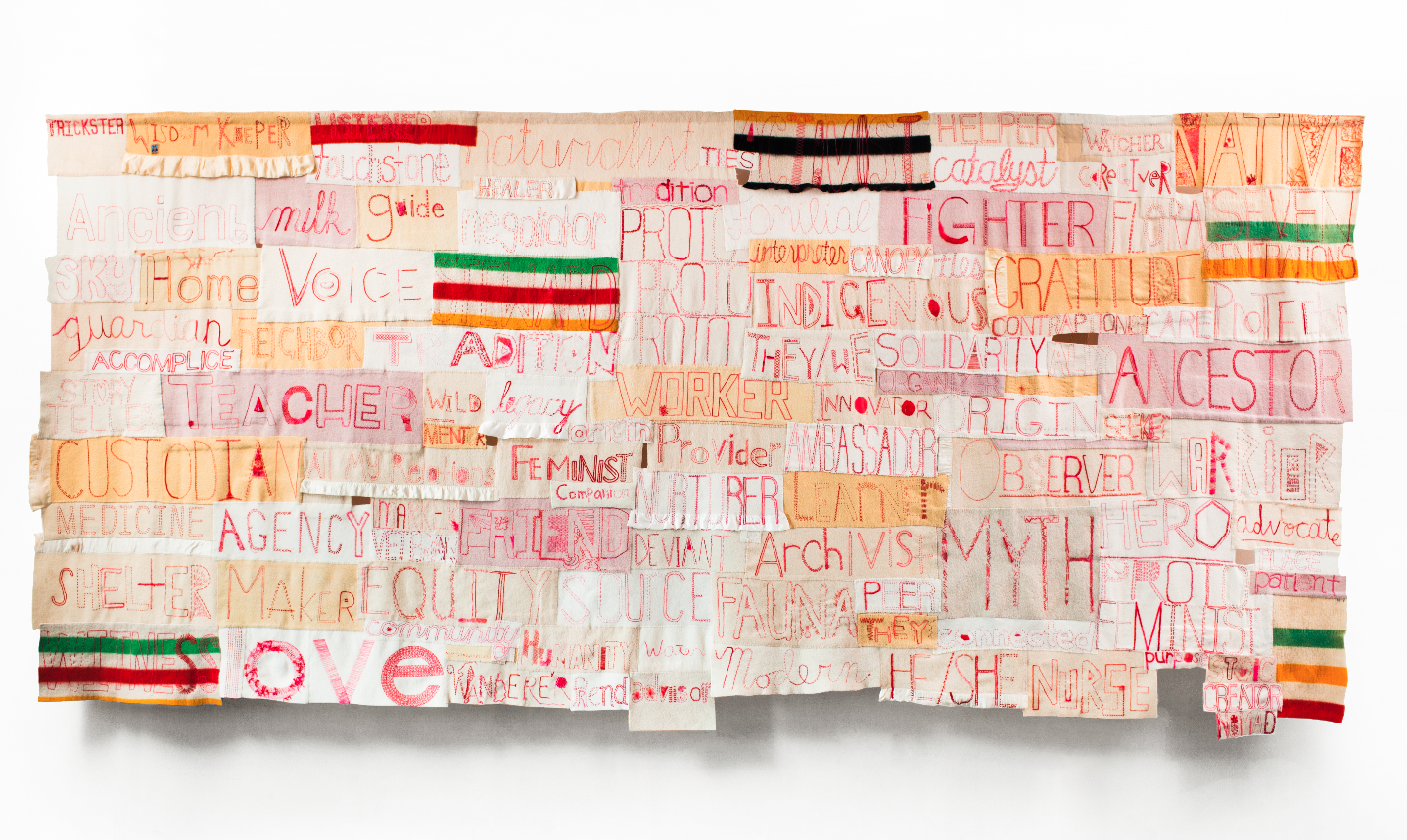
Companion Species: Ferocious Mother and Canis Familiaris, 2017
Reclaimed wool blankets, thread, and embroidery floss
Portland Art Museum. © Marie Watt. Image courtesy Portland Art Museum
When Marie Watt brings people together for sewing circles, conversations sometimes riff off a theme or prompt she provides, and at other times participants share stories on their own.
In this work, sewing circle conversations circulated around the theme of equity. Words stitched onto the surface—Equity, Love, Shelter, Solidarity, and Voice—allow us to see these concepts as materialized by many hands, unified by a single shared experience (the sewing circle) and the diverse life experiences shared in that context.
**This artwork is located in the Carlos Museum Greek and Roman Art Galleries during the exhibition at the Carlos Museum.**
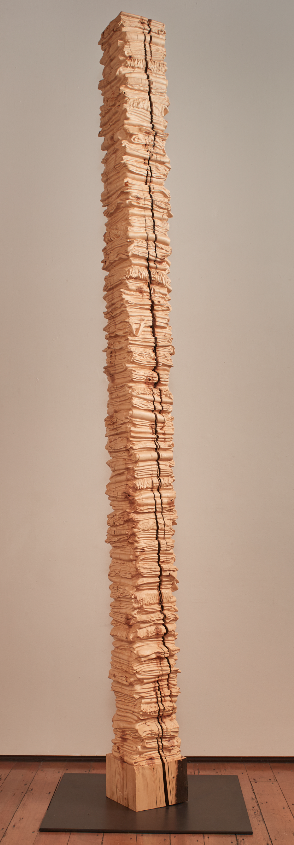
Blanket Stories: Talking Stick,
Works Progress, Steward (White Pine),
2016 Salvaged white pine from
High Desert Museum property
Lent by Firoz and Najma Lalji
Blanket Stories: Talking Stick
This soaring column of folded and stacked blankets was made from salvaged wood, once part of a train trestle connected to a sawmill. The process of carving revealed that the blackened, weathered beam was white pine. Although the tree was cut long ago, the wood still gives sap and is a testimony to wood as an enduring resource. The cracks are evidence of the wood continually changing and behaving like a living, breathing material.
The title makes reference to a talking stick used by some Native American Tribes in the context of council meetings, where it serves as a tool for learning cultural wisdom, sharing stories, and developing public speaking and listening skills.
**This artwork is located in the Carlos Museum Art of the Americas Galleries during the exhibition at the Carlos Museum.**
Marie Watt (Seneca and German-Scots)
Companion Species (Is this a pipe?), 2020
Reclaimed wool blankets, embroidery floss, and thread
Hood Museum of Art, Dartmouth: Purchased through the Miriam H. and S. Sidney Stoneman Acquisition Fund and the Acquisition and Preservation of Native American Art Fund, 2021.4
CANNUPA HANSKA LUGER
About his work:
The creation and presentation of Cannupa Hanska Luger’s artmaking practice interweave performance and political action to communicate stories about 21st-century Indigeneity. He often uses social collaboration to create artistic responses to timely and site-specific issues. Using short instructional videos distributed on social media, Luger provides instruction on a simple act, such as forming a clay bead for Every One or making a mirrored surface for the Mirror Shield Project, to invite others into his creative process. This approach has a far reach and brings together the hands of many to create something monumental. Although the collaborators may never meet, each person is invested in the meaning of the work. Each project celebrates the effort it takes to collectively affect change.
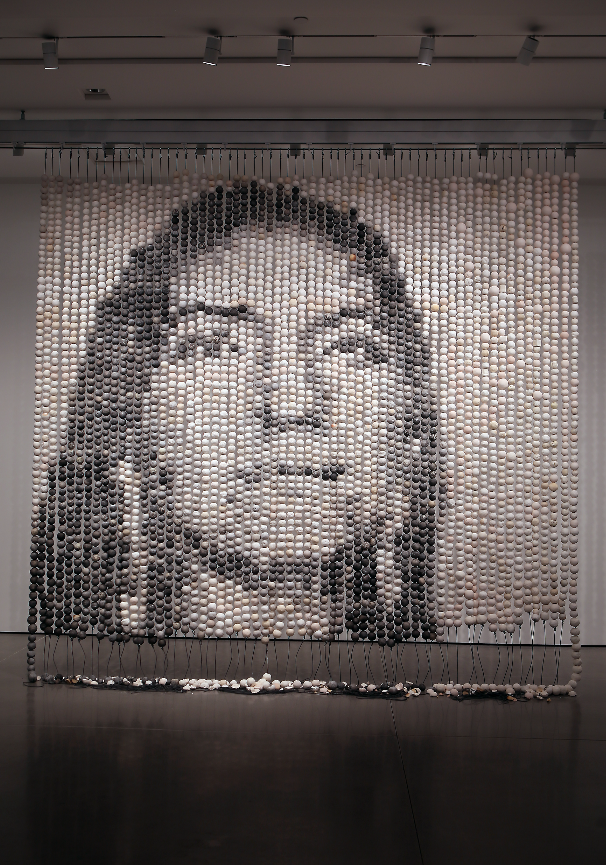
Every One, 2018
Ceramic, ink, social collaboration
Courtesy of the artist
Every One
Using over 4,000 clay beads created by many individuals, Luger calls attention to the thousands of missing and murdered Indigenous women, girls, queer, and transgender people (MMIWQT) in Canada. The image interprets Kali Spitzer’s (Kaska Dena and Jewish) 2016 photograph, Sister.
Realizing a connection between workers hired by lumber, oil, and gas companies and increased murders and disappearances, Luger asks us to shoulder some culpability in the processes that lead to such violence and to find ways to heal.
MMIWQT Bead Project
2018
Video Production by Razelle Benally
Duration: 1 min.
To watch this video, click HERE.
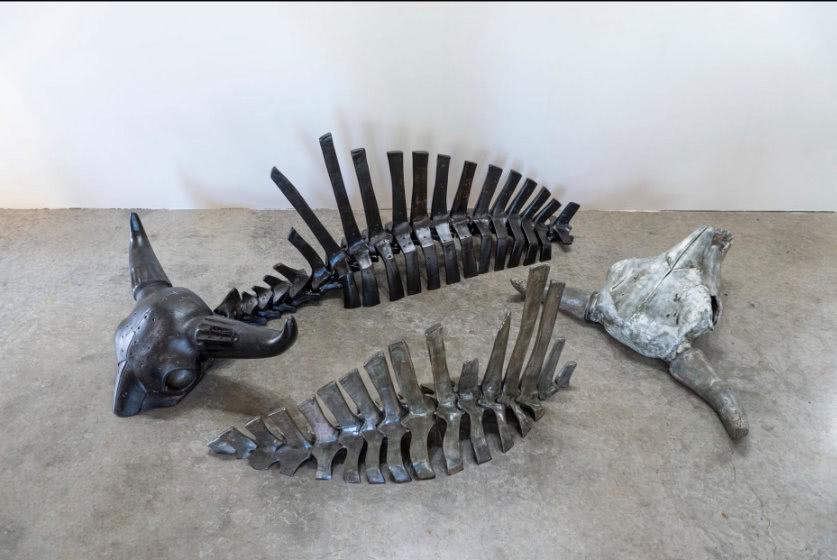
Emergent, 2021
Ceramic
Courtesy of the artist
Emergent
In the 1800s, non-Native settlers and military forces systematically slaughtered bison herds, driving the species to near extinction. This deliberate, destructive act devastated the economies, food sources, and lifeways of Plains Tribes. Cannupa Hanska Luger draws attention to how the loss of a single species impacts communities and the environment over 150 years later.
Cannupa Hanska Luger (Mandan, Hidatsa, Arikara, Lakota, European)
Mirror Shields, 2016
Masonite, mirror adhesive foil, paracord, and social collaboration
Courtesy of the artist
This call to action was a direct political response to the acts of militarized police against those defending clean water during the construction of the Dakota Access Pipeline. Through an online call for collaborators and planned workshops, people across the country created mirrored, shield-like forms for the water protectors. Holding these while on the front lines of the standoff, the water protectors forced the police officers to face their own humanity reflected in the mirrored surfaces.
To download instructions to make your own mirror shield, click HERE.
Cannupa Hanska Luger (Mandan, Hidatsa, Arikara, Lakota, European)
Sweet Land Opera Costumes:
Coyote
Bone
Coyote
Wiindigo
2020
Mixed media
Courtesy of the artist
Premiering in Los Angeles in 2020, the experimental opera Sweet Land dramatizes narratives of violence and erasure, replacing popular tales of early colonization, the rise of the United States, and its expansion into the West. Cannupa Hanska Luger’s collaborators included producers, another director, designers, composers, and performers who brought this opera to life, making it, at once, a collaboration with other people and with the land, and exposing the incomplete narratives too often told of colonial experiences.
Sweet Land (excerpt), 2020
Performed live at Los Angeles State Historic Park, March 15, 2020
Music by Raven Chacon and Du Yun
Libretto by Douglas Kearney and Aja Couchois Duncan
Directed by Cannupa Hanska Luger and Yuval Sharon
Costumes by E.B. Brooks and Cannupa Hanska Luger
Produced by The Industry
Duration 17 min 2 s
Film editing by Geoff Boothby
Audio recording by Bill Knight
Audio mixed by Lewis Pesacov
For more information about Sweet Land, visit www.theindustryla.org.
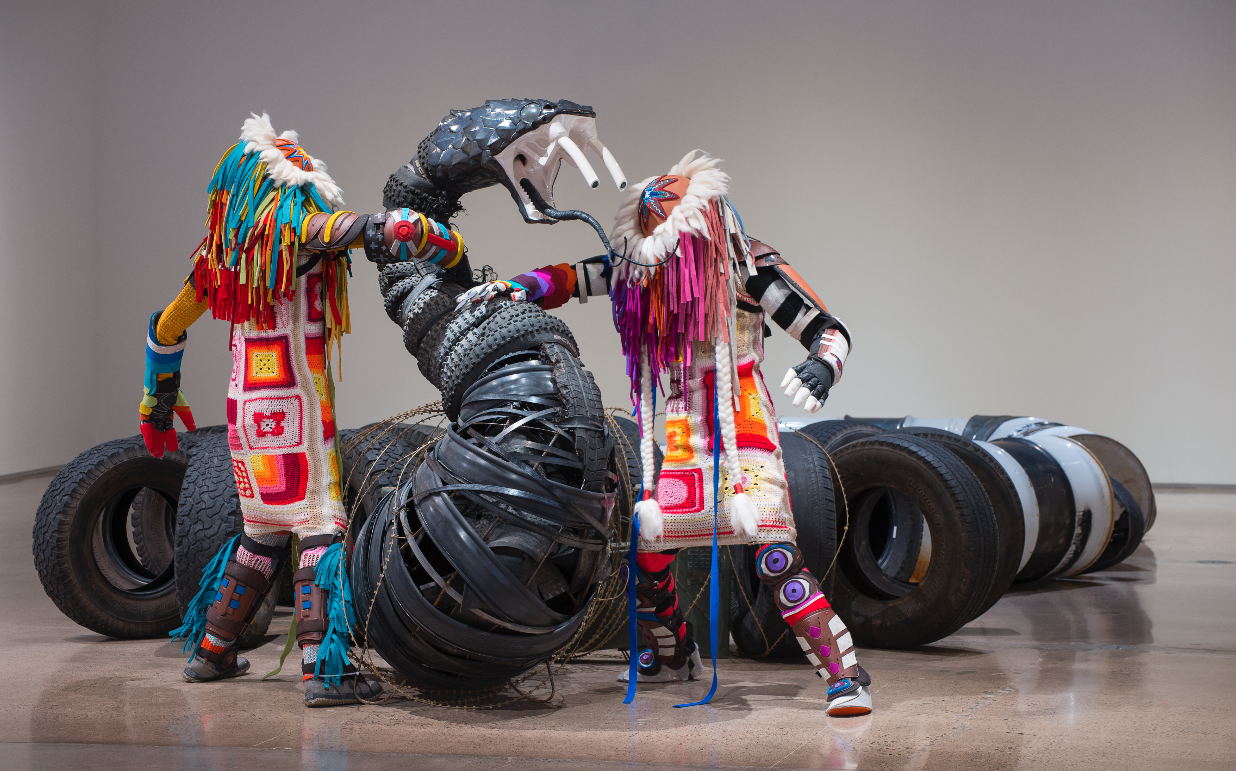
This Is Not A Snake, 2017
Ceramic, oil drums, ammunition cans, and found objects
Courtesy of the artist
Cannupa Hanska Luger (Mandan, Hidatsa, Arikara, Lakota, European)
The One Who Checks
The One Who Balances
2018
Ceramic, riot gear, afghan, wool surplus industrial felt, beadwork by Kathy Elkwoman Whitman
Courtesy of the artist
When brought together, these four works—Nature, This Is Not a Snake, The One Who Checks, and The One Who Balances —model how we might rise up against polluting forces, corporations, and attitudes that negatively impact the world around us. According to Luger, the Warrior Twins, figures from Mandan oral stories, protect Nature from environmental disaster caused by “industrial exploitation of Indigenous land and its minerals.” While the twins tell humans to act to protect nature, Luger acknowledges that nature will endure long after we are gone.
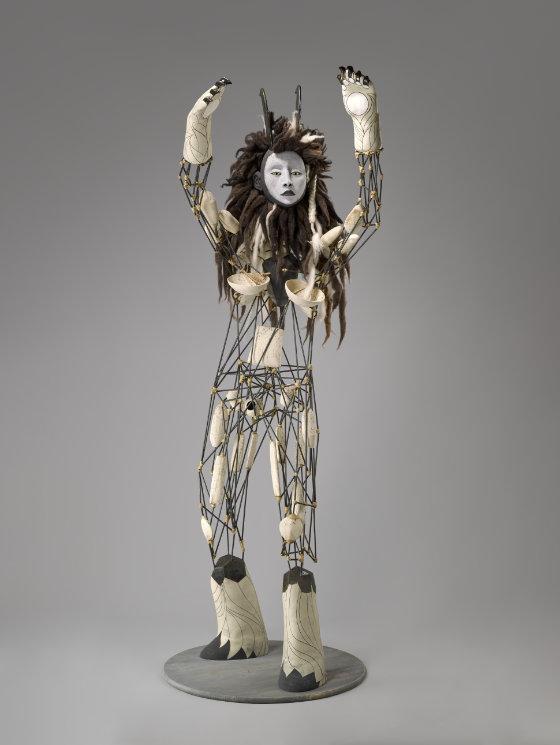
Nature, 2015
Clay, steel, and wool
Gift from Vicki and Kent Logan to the Collection of the Denver Art Museum
Cannupa Hanska Luger (Mandan, Hidatsa, Arikara, Lakota, European)
Return of the Warrior Twins, 2021
In collaboration with A Luta Continua & Ramble Creative
Single channel video
Duration 1:19 min. loop
Photographic documentation of the destruction of the Navajo Generating Station, AZ
Courtesy of the artist
This large-scale, photographic living mural video installation was created by Cannupa Hanska Luger in collaboration with Chip Thomas (A Luta Continua). It pictures the Warrior Twins, figures from Mandan oral stories, who witness and respond to the destruction of the Navajo Generating Station in Arizona.
The twins tell us to act to protect nature, but Luger acknowledges that nature is endless: “No matter how much you take and take and take, she is just going to keep going. She is going to outlast you.”
**This artwork is located in the Emory Student Center during the exhibition at the Carlos Museum.**
YOU ARE NOW AN ACCOMPLICE

Each/Other, 2020-2021
Metal, wool, bandanas, and embroidery thread
Courtesy of the artists
Every/One
Marie Watt and Cannupa Hanska Luger merged their practices to create this sculpture, along with people from around the world, during the COVID-19 pandemic. The artists asked participants to embroider messages on bandanas while considering “if acts of collaboration help heal broken bonds with the environment and with each other.” Together, these messages help us take notice of our neighbors by bringing awareness to things outside ourselves.
As you look at this monumental she-wolf and the many embroidered messages forming her colorful pelt, consider the following: How do these contributions open your eyes to the experiences of others? Can you find messages that mirror your own experiences?
Hear artists Marie Watt and Cannupa Hanska Luger talk about their inspiration and creative process in making the Each/Other she-wolf.
Produced by Steven J. Yazzie
Duration: 5 min. 3 sec.
To watch, click HERE.
Artist Quotes:
“Each person’s stitch is unique, like a thumbprint. As the threads intersect and blend, I see them as a metaphor for how we are all related.”
—Marie Watt
“Collaboration is an active agent in this work, not simply a means to an end.”
—Marie Watt
“Collaboration has always been part of my artistic process, whether it’s through gathering stories to incorporate into my work or listening to people share their stories in sewing circles.”
—Marie Watt
“Art is not an object, it’s a process. It’s a verb, not a noun.”
—Cannupa Hanska Luger
“This work requires engagement. I want to lay groundwork, to establish connections, to mobilize action.”
—Cannupa Hanska Luger
“This type of engagement combines technology and handwork to mobilize and even heal the communities who are facing immeasurable trauma from colonialization.”
—Cannupa Hanska Luger






